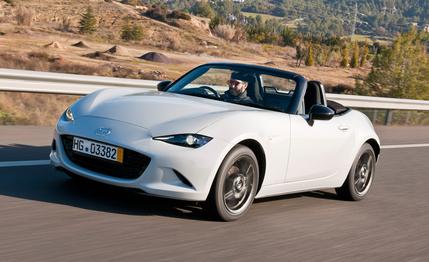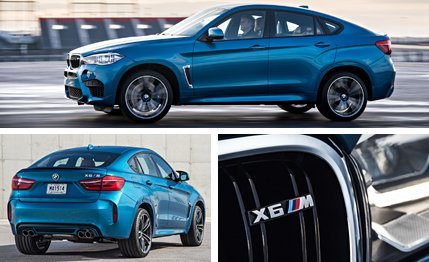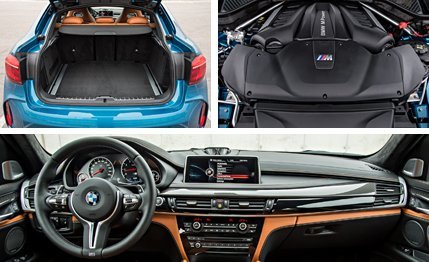
 First Drive Review
First Drive Review
When the M versions of the BMW X5 and X6 first appeared in 2009, they represented multiple heresies for the M brand: They used turbocharged engines, they had all-wheel drive, and they were—oh no!—sport-utility vehicles. Since then, BMW’s M division has pretty much brushed aside notions of what does or doesn’t constitute heresy. The new M3 and M4 use a turbocharged engine (as do the M5 and the M6). All-wheel drive is coming to the M5. And nearly 20,000 M-badged SUVs roam the streets.
Now comes round two for the M version of BMW’s SUVs, in both traditionally shaped X5 and genre-bending X6 “sports activity coupe” forms. The latter, of course, is another blow to conventionality—some might say common sense—but BMW responds by pointing to 250,000 total X6 sales since its debut in 2008. So as we head deep into the heart of Texas to drive the new X6 M, we won’t bother to examine the concept, only the execution.
Approaching a row of identical X6 Ms in Long Beach Blue lined up in the paddock at the Circuit of the Americas, the vehicle’s hulking, linebacker physique appears little changed. The 2015 X6 M is 1.8 inches longer, its width and height are within a fraction of its predecessor’s, and it rides on the same 115.5-inch wheelbase. The biggest design departures are the deep, rising crease on the rear fenders and the larger, 21-inch twin-spoke wheels (up from the previous 20s). The latter are specific to the M, which also gets a unique front fascia incorporating large air intakes and its own rear fascia with a diffuser and twin exhaust outlets, as well as side gills in the front fenders and a functional rear spoiler.
Inside, M-ness is bestowed by the M-specific sport seats, gauge cluster, and steering wheel. Upscale trim, including a leather-covered dash and a suedelike headliner, is standard. The vehicles on hand for our test drive are further fancified with the optional full-leather interior, carbon-fiber trim, and excellent, high-backed, multicontour seats. In all, the materials and execution are befitting of a six-figure luxury SUV (starting price: $103,050).


This second-generation X6 M’s mechanical package also doesn’t stray far from the original’s. The engine and transmission are new, but the engine retains its same configuration and displacement. The 4.4-liter V-8 again features two twin-scroll turbos nestled within the cylinder banks’ V, plus a cross-bank exhaust manifold. A variant of the engine in the M5/M6, it utilizes BMW’s Valvetronic variable valve timing and lift system and claims a lower rotating mass than its predecessor for quicker response. Output climbs by 12 ponies and 53 lb-ft to an impressive-sounding 567 horsepower and 550 lb-ft. That keeps it meaningfully ahead of the X6 xDrive50i, which gets 445 horsepower from its own 4.4-liter turbo V-8.
Worryingly for BMW, however, Porsche’s just-announced Cayenne Turbo S and the new Mercedes-AMG GLE63 S coupe both boast higher horsepower numbers (570 and 577). We suspect that bragging rights here are no small consideration to buyers in this category. BMW claims to have sliced half a second from the zero-to-60-mph time, now 4.0 seconds (for our part, we postulate 3.9 seconds). Again, though, Porsche is quoting a better time of 3.8 seconds. Porsche further claims a 176-mph top speed for the Turbo S, while BMW limits the X6 M to 155 mph, although buyers in other markets can opt for a 174-mph limiter.
In place of the previous six-speed automatic, BMW mates its new engine to an eight-speed gearbox. It uses the same annoyingly fiddly shift knob as the M DCT dual-clutch gearbox in BMW M passenger cars, but this is a torque-converter automatic. That’s fine, though, as it means smoother takeoffs pulling away from a stop; its shift times, which can be adjusted in three steps just like the M DCT’s, are still right quick. So is the X6 M itself, even if the powertrain is not quite as extroverted as its numbers suggest. The exhaust system, which incorporates a bypass flap, isn’t nearly Jaguar F-type–loud, for example. Finally, while it might not matter much to this audience, the eight-speed’s wider ratio spread, together with the more efficient new engine, are said to boost overall fuel economy by some 20 percent. EPA figures aren’t yet available, it must be noted.
One of the more significant changes to the chassis is a switch to electric steering assist, now with Comfort, Sport, and Sport+ modes. The steering is no longer overly heavy, even in Sport+ mode, and effort build-up is natural; just don’t expect much road feel to make its way to the fat, sausage-casing-smooth steering-wheel rim.


The move from hard-riding run-flat tires to more compliant, non-run-flats brings one of the more notable improvements in everyday driving. Greatly reduced impact harshness has mellowed the formerly brutal ride—or so says the smooth, gently undulating pavement of central Texas—although the X6 M occasionally exhibits stiff, bouncy body motions.
As before, the X6 M utilizes adaptive dampers, steel front springs, and rear air springs, but the bushings are new. Chief vehicle integration engineer Walter Haupt says the retuning effort focused on reducing understeer. Indeed, around the big and fast Circuit of the Americas track, the X6 M doesn’t push nearly as much as you’d expect, its rear-biased all-wheel drive and torque vectoring helping the rear end do its part. The absence of body roll also defies expectations, and the vehicle is unperturbed when we rumble over the lumpy curbing. The brakes, which now feature cross-drilled rotors, six-piston (up from four) front calipers, and 50-percent greater surface area, prove highly effective at repeatedly hauling down this big machine without fading.
As capable as it is, you wouldn’t describe the X6 M as fluid. Sitting high in the saddle, you’re ever conscious of the X6 M’s mass. This M car can get around a racetrack, but it’s much more about blasting down the road in a straight line. The massive, ultra-high-performance Michelin Pilot Sport tires (285/35-21 up front, 325/30-21 at the rear) provide all kinds of grip, and in a vehicle this tall and heavy, grip is probably what you want. Ultimately, though, it makes for a car that’s impressive rather than fun. Ah, but we’re slipping into a philosophical discussion, and we said we weren’t going to go there.
Instead we’ll say that, while the X6 M is hardly our favorite incarnation of BMW’s M brand, the 2015 model offers both higher performance and greater refinement than its pioneering predecessor. We’ll see whether that will enable the X6 M to maintain its edge as rivals encroach on the niche that it created.